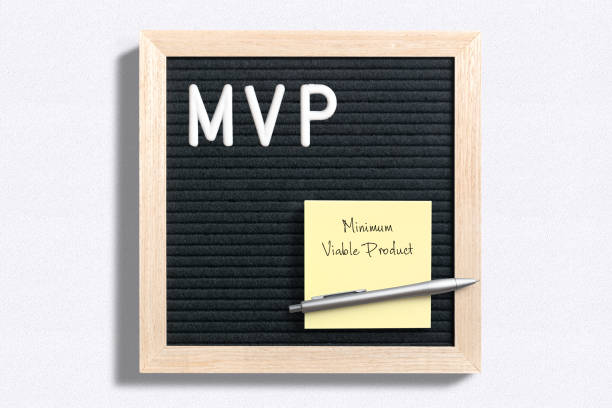Before diving into the mass information, let’s understand the meaning of minimum viable product, or “MVP,” and its types.
What Is MVP?
MVP stands for “minimum viable product.”
A team develops a new product with essential features to showcase its core functionality.
The MVP approach lets a team collect feedback from early users.
They use this to improve the product and optimize development.
The MVP approach is often used in the startup and tech industries.
A company quickly tests market demand for a product without heavy investment in development.
This approach helps minimize risk and allows the company to pivot and make changes based on user feedback.
The MVP is a basic product version that offers value to early adopters.
The team gathers data and feedback from real users.
They use this information to improve the product and guide future development.
There are several benefits to using the MVP approach.
A team quickly tests market demand, gathers feedback, and reduces development costs.
A team iterates and improves the product based on real user feedback rather than assumptions.
Overall, the MVP approach helps companies bring new products to market cost-effectively and with lower risk.
Innovative Tech Solutions, Tailored for You
Our leading tech firm crafts custom software, web & mobile apps, designed with your unique needs in mind. Elevate your business with cutting-edge solutions no one else can offer.
Start NowRead: What are the Top Funding Options for Startup Ventures?

Types of Minimum Viable Products
Several types of MVPs can be used in product development, and they are:
1. Concierge MVP
The concierge MVP is a development technique in which a new product is developed with just enough features to allow early users to experience its core functionality.
However, rather than building out the full product, the team manually performs the core functionality for each user.
This allows the team to gather valuable feedback and validate the concept before investing in full product development.
The concierge MVP approach is often used when the product’s core functionality requires a high level of customization or personalization for each user.
This approach allows the team to get a sense of what users want and need and gather valuable feedback that can guide future development efforts.
One example of a company that uses the concierge MVP approach is Zappos, the online shoe and clothing retailer.
The company didn’t have a fully functional e-commerce website when they first launched.
Instead, the team manually took orders over the phone and then sourced the products from other retailers.
This allowed the team to validate the demand for their product and gather valuable feedback from early users, which helped guide the development of their full e-commerce platform.
Overall, the concierge MVP approach is a useful tool for companies looking to bring a new product to market cost-effectively and risk-averse.
By manually performing the core functionality for early users, the team can validate the concept and gather valuable feedback to guide future development efforts.
Read: How to Build a Minimum Viable Product (MVP) for a Startup?
2. Wizard of Oz MVP
The “Wizard of Oz MVP” creates a simulated product to test feasibility and gather user feedback before full development.
The concept is named after “The Wizard of Oz,” where an ordinary man behind a curtain seems magical.
The Wizard of Oz MVP simulates a fully functional product, manually controlled behind the scenes, to test viability and gather feedback.
The Wizard of Oz MVP gathers information about the product and its users before committing significant resources.
This approach helps reduce the risk of developing a product that doesn’t meet user needs.
A company creates a simple prototype and manually fulfills requests to gather feedback and data.
This approach allows companies to test a product’s viability quickly and cheaply before full development.
Read: Prototype vs MVP: What is the Difference?
3. Landing page MVP
A landing page MVP (minimum viable product) is a type of MVP specifically designed to test the viability of a product or service through a simple landing page website.
It is a fast and cost-effective way to gather feedback and data about a product or service before investing significant time and resources into building out a full version.
Seamless API Connectivity for Next-Level Integration
Unlock limitless possibilities by connecting your systems with a custom API built to perform flawlessly. Stand apart with our solutions that others simply can’t offer.
Get StartedTo create a landing page MVP, a company will create a simple one-page website that provides information about the product or service, including its features and benefits.
The landing page may also include a sign-up form or a call-to-action (CTA) button that allows users to express interest in the product or service.
The goal of a landing page MVP is to test market demand for the product or service, as well as gather feedback about its features and benefits.
By measuring the number of visitors to the landing page and the number of sign-ups or CTAs, a company can gain valuable insights into the product’s potential market and how it might be improved.
A landing page MVP can be a particularly useful tool for companies that are just starting out.
It allows them to test their product or service quickly and cheaply before committing significant resources to building out a full version.
It is also an effective way to gather user feedback and data that can be used to refine the product or service before it is launched.
Read: How to Validate Your Startup Idea Before Starting
4. Single feature MVP
A single-feature MVP, or the “minimum viable product,” is a product with only one core feature or functionality.
Its purpose is to quickly test a product idea with a small group of users to gather feedback and validate the product concept.
This approach allows a business to gather valuable data about the product’s market fit and demand and make informed decisions about continuing development and investment.
The key advantage of a single-feature MVP is that it allows a business to get a product to market faster and at a lower cost than building a full-featured product.
This approach also minimizes risk, as the business can gather data and make decisions based on real user feedback rather than assumptions.
However, there are some limitations to single-feature MVPs.
Because the product has only one core feature, it may not be fully functional or solve all user needs.
Additionally, users may not fully understand the product’s potential or value without experiencing multiple features.
As a result, it may be more difficult to generate significant traction or revenue with a single-feature MVP.
Overall, a single-feature MVP is a useful tool for businesses looking to test the viability of a product idea with a minimal investment of time and resources.
It can provide valuable insights and help a business make informed decisions about the product’s future development.

5. Customer development MVP
Customer development MVP, or the “minimum viable product,” is a product that is designed specifically to gather feedback and validate a product concept with customers.
The goal of a customer development MVP is to quickly test a product idea with a small group of users and gather data about the product’s market fit and demand.
One key aspect of customer development MVP is its focus on the customer and their needs.
This approach involves actively seeking out and engaging with potential customers to understand their pain points and needs, and using that information to inform the development of the product.
This approach helps a business validate its product concept and ensure that the product meets the target market’s needs.
Transform Business with Custom CRM & ERP Solutions
Elevate your operations with a CRM or ERP tailored for you. Let’s build the perfect solution that others can't replicate—crafted to match your business's needs like no other.
Get StartedCustomer development MVPs can take various forms, including prototypes, demos, and functional MVPs.
The specific form of the MVP will depend on the product and the target market’s needs.
There are several advantages to using a customer development MVP approach.
First, it allows a business to gather valuable feedback and data from potential customers early in the product development.
This can help a business make informed decisions about the product’s direction and potential market fit.
Additionally, a customer development MVP can help a business build relationships with its target market, which can be valuable for future product development and marketing efforts.
Overall, a customer development MVP is useful for businesses looking to validate their product concept with customers and gather data about the product’s market fit and demand.
It can help a business make informed decisions about the product’s development and potential success on the market.
Later, we will make a post on the many examples of MVP and its importance to startups and tech companies.
Turn on your notifications so you don’t miss them.
Conclusion
In summary, understanding the various types of MVPs is crucial for startups to minimize risk and optimize resources.
Understanding the various types of MVPs is crucial for startups to minimize risk and optimize resources.
Choosing the right MVP approach allows businesses to gather user feedback, validate concepts, and make informed development decisions.
Each method—concierge MVP, Wizard of Oz MVP, landing page MVP, single-feature MVP, or customer development MVP—offers unique advantages for specific business goals.
Stay tuned for more insights and examples of how MVPs can drive success in your product development journey.
Before you go…
Hey, thank you for reading this blog to the end. I hope it was helpful. Let me tell you a little bit about Nicholas Idoko Technologies.
We help businesses and companies build an online presence by developing web, mobile, desktop, and blockchain applications.
We also help aspiring software developers and programmers learn the skills they need to have a successful career.
Take your first step to becoming a programming boss by joining our Learn To Code academy today!
Be sure to contact us if you need more information or have any questions! We are readily available.











